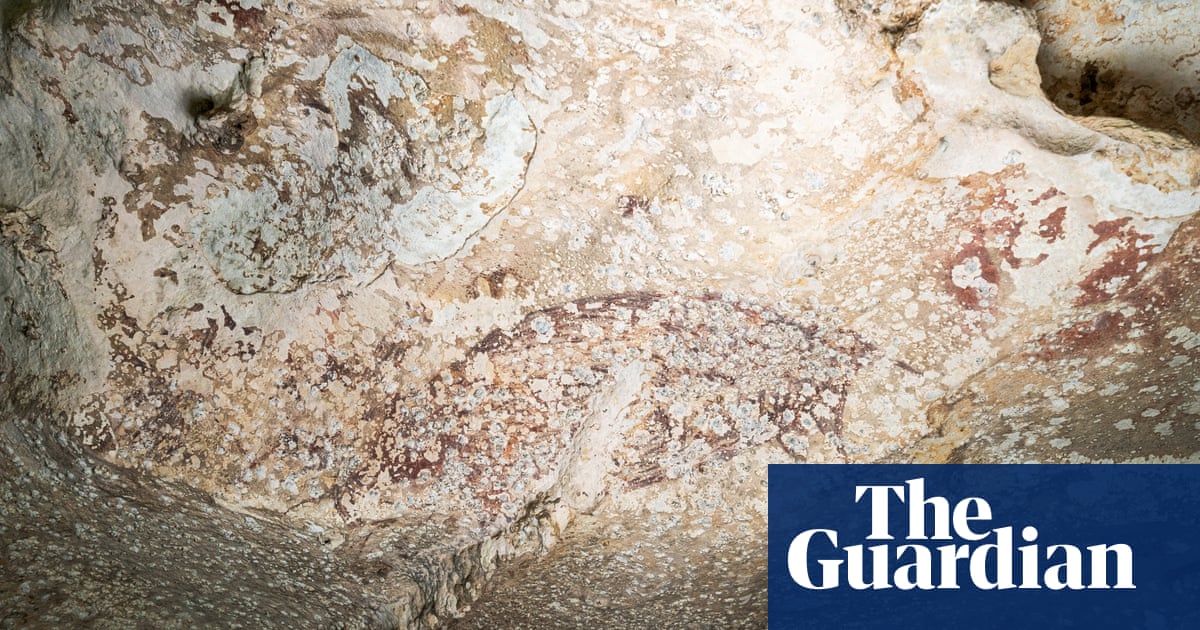World
Oldest known picture story is a 51,000-year-old Indonesian cave painting

The world’s oldest known picture story is a cave painting almost 6,000 years older than the previous record holder, found about 10km away on the same island in Indonesia, an international team of archaeologists has said.
The painting, believed to be at least 51,200 years old, was found at Leang Karampuang cave on the east Indonesian island of Sulawesi, researchers from Griffith University, Southern Cross University and the Indonesian National Research and Innovation Agency wrote in the journal Nature.
Samples were collected in 2017, but weren’t dated until earlier this year.
The previous record holder was a lifesize picture of a wild pig believed to be created at least 45,500 years ago in a cave at Leang Tedongnge.
The recently discovered painting is of three therianthropes – or human-animal hybrids – and a wild pig.
Adhi Agus Oktaviana, the lead author and a PhD student at Griffith University, said the findings were “very surprising … none of the famous European ice age art is anywhere near as old as this with the exception of some controversial finds in Spain”.
Spanish scientists have previously claimed art at three sites – in Cantabria, Andalusia and Extremadura – was more than 64,000 years old. However, according to Dr Tristen Jones, a rock art expert at the University of Sydney, those findings were “largely rejected by the international science community”.
Jones said the Spanish researchers had not clearly established the crusts that were sampled formed on top of the art. The findings were also controversial because the researchers argued Neanderthals made the art.
The finding contradicts the academic view that early figurative cave art consisted of single figure panels rather than scenes where figures interacted with each other.
The researchers used uranium series dating to date the layers of calcium carbonate that had formed on top of the art. It involved extracting limestone samples that were then vaporised with a laser. The age of the sample was calculated by measuring the ratio of thorium to uranium.
The researchers said this method allowed the layers to be dated more accurately by ensuring younger and older materials were not mixed together.
The researchers also dated art at a nearby cave – Leang Bulu’ Sipong 4 – that was previously believed to be the oldest cave art in the world. They found that the artwork, once believed to be at least 44,000 years old, was at least 48,000 years old.
However, the site of the former oldest known cave painting at Leang Tedongnge could not be dated using the newer method, as there was no calcium carbonate material remaining.
Jones said the new method was “a major leap forward in tightening up the resolution and accuracy of dating”. Typically, she said, rock art is extremely difficult to date as the art is predominately made from minerals.
Adam Brumm, a professor from Griffith University who jointly led the study, said that in the hundreds of excavations he had conducted in the region, there were frequent depictions of the warty pig. “They were clearly economically important to these elite people,” he said. “We can see they were also important to them symbolically and perhaps even spiritually”.
However, the researchers said the events taking place in the artwork were “difficult to interpret”, and it was unclear what animals inspired the human-animal hybrids as they were drawn as “essentially stick figures”.
“For whatever reason … early humans … [are] rarely depicted any form that could be reasonably interpreted as a human,” Brumm said. “Animals were often drawn with incredible anatomical fidelity, but [early cave painters] put less effort into doing that.”
He said the researchers were fairly certain one of the human-animal hybrids was a human with the head of a bird, and another had a tail, believed to be that of a civet.
“Storytelling is a hugely important part of human evolution and possibly even helps to explain our success as a species, but finding evidence for it in art, especially in very early cave art, is exceptionally rare.”







:max_bytes(150000):strip_icc()/roundup-writereditor-loved-deals-tout-f5de51f85de145b2b1eb99cdb7b6cb84.jpg)


